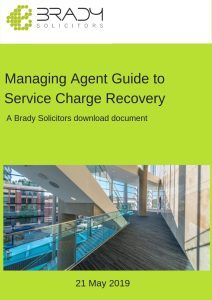Brady Solicitors explain why it’s important for management companies to understand the difference between a reserve fund and a sinking fund, and how misuse of either fund could see your service charge contributions reduced by the First-tier Tribunal.
Many leases will cover a contribution towards a reserve fund in the service charge payment. A reserve fund is part of good block management as it is designed to ensure leaseholders help contribute towards unexpected expenses. A sinking fund is similar to a reserve fund as a means of collecting funds but is for more specific purposes.
Reserve funds
The reserve fund is built up over a short period of time, such as a year or two, to an amount that the landlord believes is needed to cover an unexpected shortfall. With good budgeting and management of the block, the reserve fund generally does not need to be a large amount and acts as a top up of service charge contribution as and when needed.
Some leases may clearly state how much leaseholders need to contribute to the reserve fund each year. However, most leases do not stipulate an amount so it is down to the landlord to determine the amount leaseholders have to contribute, subject to reasonableness. As with any kind of service charge, leaseholders have the right to challenge the service charge by an application to the First-tier Tribunal.
What is the reserve fund used for?
The reserve fund helps management companies to prepare for, and manage unexpected expenditure that the service charge budget could not account for. The reserve fund has several distinct characteristics and advantages:
- Helps deal with overspend: As it is difficult to know exactly what the yearly expenditure will be on the block, the reserve fund acts as an overdraft on a range of costs such as unexpected communal repair bills. Building up a reserve fund a short period ensures you can bridge the gap between the budget and actual expenditure.
- Buffer for leaseholders: No one likes the idea of being hit with a large bill they cannot manage, and in the same way the service charge works, the reserve fund helps to protect leaseholders from being hit with large bills on unexpected expenses in one go.
- Recover unexpected costs: In the event of the lease containing a sweeper clause, you may be able to recover certain costs from the service charge through the reserve fund, which again prevents leaseholders being faced with a large bill. However do not assume that all costs this can be recovered through this method.
How a sinking fund is different to the reserve fund
Sinking funds on the surface do not appear vastly different to reserve funds, especially if the wording of the lease is vague. Essentially however, the sinking fund differs from the reserve fund as a mean of collecting extra funds for specific costs that occur occasionally. A good example of this is using the sinking fund for periodic maintenance such as painting or roof repairs that are needed every 5 years or 10 years.
A cyclical maintenance report done by a qualified surveyor or professional will determine the type of works required on the block and over what time period. This can help ascertain time scales and rough costs for future works so appropriate contribution amounts can be calculated.
Holding funds in trust
The recent case of Caribax v Hinde House Management Company [2015] UKUT 0234 (LC) reminds landlords of the importance of complying with S.42 of the Landlord and Tenant Act 1987 to hold reserve and sinking funds in trust. The reserve/sinking funds should be held in a separate bank account to the service charge monies.
Remember the reserve fund and/or sinking fund are still part of the service charge.
Regardless if your lease has a provision for reserve or sinking fund, or both, it is importance to treat the funds in terms of reasonableness when sending the demands for service charge to leaseholders. As with any kind of service charge, leaseholders have the right to challenge the service charge by an application to the First-tier Tribunal which may result in the service charge amount being reduced.
We recommend to our clients to keep their leaseholders informed on the presence and use of the reserve/sinking fund through use of an annual statement.


